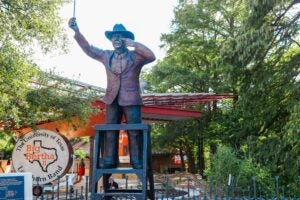AUSTIN, Texas–Dr. Carl Anderson can’t remember exactly when he realized he was Santa Claus. It may have been one day in 1978 when he was crossing the street at 26th and Guadalupe like any other bearded young Austinite. A group of nearby schoolchildren yelled, ‘Hey, Look! There’s Santa Claus,’ and practically mobbed him.
It hasn’t been the same for The University of Texas at Austin adjunct assistant professor of educational psychology since.
“I wasn’t setting out to be Santa Claus. I just grew the beard to join Austin’s counterculture. That’s what you did in the 1970s,” Anderson laughed (with a definite twinkle in his blue eyes). He went on to get several degrees at UT Austin, including a Ph.D. in counseling psychology. His dissertation topic: Children’s reaction to the reality of the Santa Claus myth.
Anderson was dubbed “the Santa Scholar,” and, for the last several years, he has portrayed jolly old St. Nick during the holiday season at malls in Austin and California. Since 1987, he has been personifying Santa at NorthPark Center in Dallas. By Anderson’s calculation, more than 140,000 children have sat on his lap, and a fourth of them came with a “Letter to Santa” wish list clinched in hand.
The 45-year-old psychologist, with co-author Jim Walker Jr., recently published many of those letters in a new book, All I want for Christmas Is…Letters from Santa’s Mailbag. The book is published by Health Communications Inc., publisher of the Chicken Soup for the Soul books.
The letters represent the first in a planned series of collaborations. Most of them were given to Anderson as Santa, and some were gathered directly from post offices in New York City and Dallas. A portion of the book’s proceeds will be donated to the Feed the Children charity.
The letters come in all sizes, shapes, styles, colors and formats, said Anderson, who teaches introduction to counseling in the spring and summer semesters. The record stands as an 84-page tome filled with carefully cut-out pictures (from advertisements and store catalogs). “The letters may be written in a barely decipherable scrawl (sometimes accompanied by a parent’s translation) or, alas, increasingly they may be projected in the latest high-tech computer-aided format.
“Fortunately, no child has yet simply handed over or mailed in a disk, floppy or otherwise,” he said.
“These forthright and often poignant letters are a reminder that Santa is one of children’s first confidants,” said Anderson, who also keeps a journal of anecdotes and quotes during his Santa stints. “Children have pressed into my hand letters that are funny, sad, sweet and sometimes disarmingly frank.
“The first child who sat on my lap was a curly headed 5-year-old boy. He made himself comfortable, looked me right in the eye and said, ‘My Daddy left us and moved to Waco. I guess he doesn’t love us anymore.’ I realized then that, as Santa, I was going to hear about a lot more than which G.I. Joe or Barbie doll children wanted for Christmas.”
Anderson said he tries to make sure the child always feels heard and is not rushed. “Kids reflect what is going on in the culture and in their homes. Sometimes it’s hard because I see kids and families who are obviously not in the best of situations, and there’s little I can do.
He remembers one little girl who came to him in a wheelchair with an IV bag and hospital wrist band. “She said all she wanted for Christmas was to go home. I told her I couldn’t promise, but that I would make that my wish for her.
“At times like this, you wish you were Santa.”
The best part about being Santa is “making that wonderful brief connection to children–being able to experience the magical way they view the world. For some, Santa is a consistently loving father figures; others are awed and amazed by his magic. For all, he is a keeper of secrets and a living representation of hope.”
Being Santa and having that many children crawling on and off your lap each can be physically tiring and make for a long day. “Sometimes, though, I see my reflection in their eyes for just a second, and I find myself getting a second breath.”



